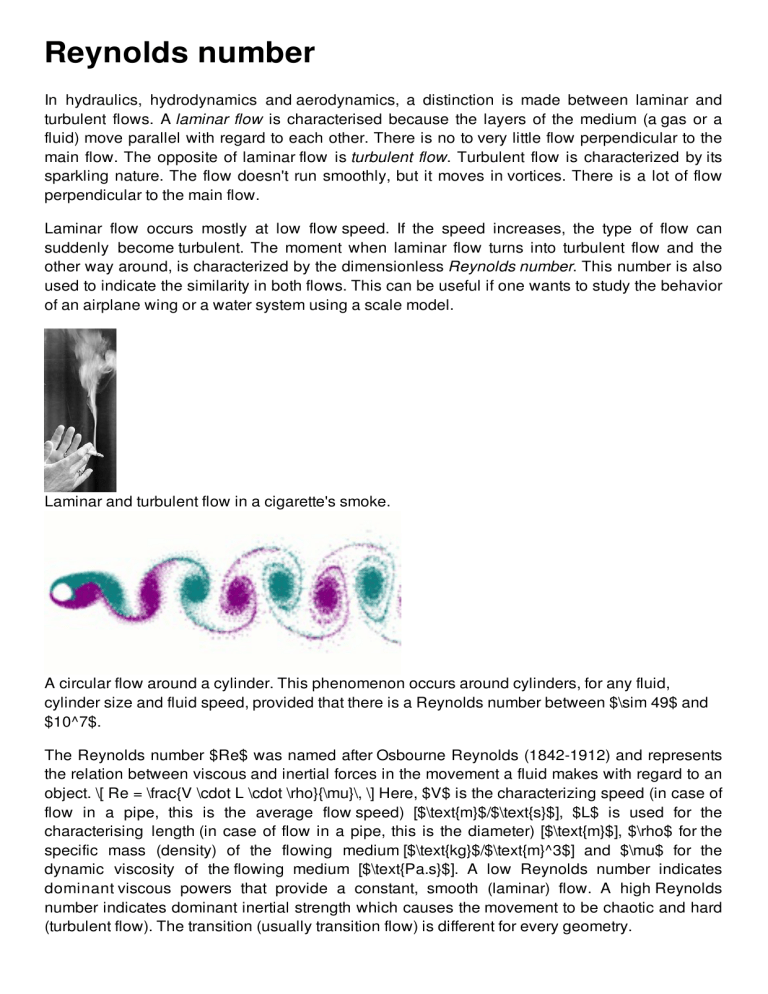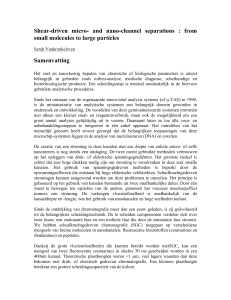
Reynolds number
In hydraulics, hydrodynamics and aerodynamics, a distinction is made between laminar and
turbulent flows. A laminar flow is characterised because the layers of the medium (a gas or a
fluid) move parallel with regard to each other. There is no to very little flow perpendicular to the
main flow. The opposite of laminar flow is turbulent flow. Turbulent flow is characterized by its
sparkling nature. The flow doesn't run smoothly, but it moves in vortices. There is a lot of flow
perpendicular to the main flow.
Laminar flow occurs mostly at low flow speed. If the speed increases, the type of flow can
suddenly become turbulent. The moment when laminar flow turns into turbulent flow and the
other way around, is characterized by the dimensionless Reynolds number. This number is also
used to indicate the similarity in both flows. This can be useful if one wants to study the behavior
of an airplane wing or a water system using a scale model.
Laminar and turbulent flow in a cigarette's smoke.
A circular flow around a cylinder. This phenomenon occurs around cylinders, for any fluid,
cylinder size and fluid speed, provided that there is a Reynolds number between $\sim 49$ and
$10^7$.
The Reynolds number $Re$ was named after Osbourne Reynolds (1842-1912) and represents
the relation between viscous and inertial forces in the movement a fluid makes with regard to an
object. \[ Re = \frac{V \cdot L \cdot \rho}{\mu}\, \] Here, $V$ is the characterizing speed (in case of
flow in a pipe, this is the average flow speed) [$\text{m}$/$\text{s}$], $L$ is used for the
characterising length (in case of flow in a pipe, this is the diameter) [$\text{m}$], $\rho$ for the
specific mass (density) of the flowing medium [$\text{kg}$/$\text{m}^3$] and $\mu$ for the
dynamic viscosity of the flowing medium [$\text{Pa.s}$]. A low Reynolds number indicates
dominant viscous powers that provide a constant, smooth (laminar) flow. A high Reynolds
number indicates dominant inertial strength which causes the movement to be chaotic and hard
(turbulent flow). The transition (usually transition flow) is different for every geometry.
Input
Four real numbers $V$, $L$, $\rho$ and $\mu$ that represent the quantities as they are used in
the formula of the Reynolds number (expressed in SI-units). Each number is on a separate line.
Output
A real number that represents the Reynolds number calculated based on four quantities given in
the input. This number is followed on the same line by a space and the type of flow that
corresponds with the calculated Reynolds number between round brackets. For Reynolds
numbers smaller than 2,000 this is laminar flow, for Reynolds numbers between 2,000 and 4,000,
this is transition flow, and for Reynolds numbers larger than 4,000 this is turbulent flow.
Example
Input:
40.2
2.0
991.0
72.0
Output:
1106.616667 (laminar flow)
Epilogue
In de hydraulica, hydrodynamica en aerodynamica wordt onderscheid gemaakt tussen laminaire
en turbulente stromingen. Een laminaire stroming kenmerkt zich doordat de lagen van het
medium (een gas of een vloeistof) zich parallel ten opzichte van elkaar voortbewegen. Er is geen
of nauwelijks stroming loodrecht op de hoofdstroom. De tegenpool van laminaire stroming is
turbulente stroming. Turbulente stroming kenmerkt zich door een wervelende karakter. De
stroming loopt niet gelaagd, maar verplaatst zich in wervels. Er is veel stroming loodrecht op de
hoofdstroom.
Laminaire stroming vindt vooral plaats bij lage stroomsnelheden. Wordt de snelheid groter, dan
kan het type stroming ineens turbulent worden. Het moment waarop laminaire stroming overgaat
i n turbulente en andersom, wordt gekarakteriseerd door het dimensieloze Reynoldsgetal. Dit
getal wordt ook gebruikt om de similariteit tussen twee stromingen weer te geven. Dit kan nuttig
zijn als men het gedrag van een vliegtuigvleugel of een waterstelsel wil onderzoeken aan de
hand van een schaalmodel.
Laminaire en turbulente stroming in de rookpluim van een sigaret.
Een wervelstroom rond een cylinder. Dit fenomeen komt voor rond cylinders, en dit voor elke
vloeistof, cylindergrootte en vloeistofsnelheid, op voorwaarde dat het Reynoldsgetal tussen $\sim
49$ en $10^7$ ligt.
Het Reynoldsgetal $Re$ werd vernoemd naar Osbourne Reynolds (1842-1912) en geeft de
verhouding weer tussen de visceuze en de intertiaalkrachten in de beweging die een vloeistof
maakt ten opzichte van een object. \[ Re = \frac{V \cdot L \cdot \rho}{\mu}\, \] Hierbij $V$ staat voor
de karakteristieke snelheid (in het geval van stroming door een buis is dit de doorsnedegemiddelde stroomsnelheid) [$\text{m}$/$\text{s}$], $L$ voor de karakteristieke lengte (in het
geval van stroming door een buis is dit de diameter) [$\text{m}$], $\rho$ voor de soortelijke
massa (dichtheid) van het stromende medium [$\text{kg}$/$\text{m}^3$] en $\mu$ voor de
dynamische viscositeit van het stromende medium [$\text{Pa.s}$]. Een laag Reynoldsgetal wijst
o p dominante visceuze krachten die voor een constante vlotte (laminaire) stroom zorgen. Een
hoog Reynoldsgetal wijst dan weer op dominante intertiaalkrachten waardoor de beweging
chaostisch en moeilijk verloopt (turbulente stroming). Het omslagpunt (meestal een
omslaggebied) is voor elke geometrie anders.
Invoer
Vier reële getallen $V$, $L$, $\rho$ en $\mu$ die staan voor de grootheden zoals die gebruikt
worden in de formule voor het Reynoldsgetal (uitgedrukt in SI-eenheden). Elk van deze getallen
staat op een afzonderlijke regel.
Uitvoer
Een reëel getal dat staat voor het Reynoldsgetal berekend op basis van de vier grootheden
gegeven in de invoer. Dit getal wordt op dezelfde regel gevolgd door een spatie en tussen ronde
haakjes het type stroming dat overeenkomt met het berekende Reynoldsgetal. Voor
Reynoldsgetallen kleiner dan 2000 is dit laminaire stroming, voor Reynoldsgetallen tussen 2000 en
4000 is dit omslagstroming, en voor Reynoldsgetallen groter dan 4000 is dit turbulente stroming.
Voorbeeld
Invoer:
40.2
2.0
991.0
72.0
Uitvoer:
1106.616667 (laminaire stroming)
Epiloog



